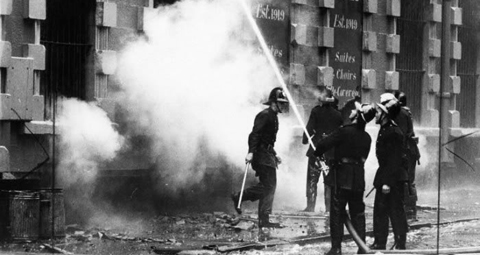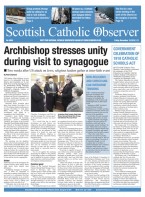BY Ryan McDougall | November 16 | ![]() 0 COMMENTS
0 COMMENTS ![]() print
print

Remembering Glasgow’s inferno
Ahead of the James Watt Street fire’s 50th anniversary memorial in Glasgow this weekend, Ryan McDougall speaks to a woman who lost her father to the blaze all those years ago.
ON MONDAY November 18 1968, a father kisses his wife and kids goodbye and sets off to work as an upholster in Glasgow city centre. He doesn’t return.
Joyce Davies’ father, Henry Fulton Brown, was one of 22 to die that day in the James Watt Street fire, one of Glasgow’s biggest tragedies since the Second World War.
The factory, a former whisky bond, was run by Julius and Samuel Stern. A glass company, G Bryce, occupied the basement and ground floor.
The fire service was notified that the building was ablaze at around 10.30am. Dozens of firefighters attended.
Workers trapped inside used furniture to relentlessly bash the barred windows, to no avail.
It was an event that shook Scotland, caused by gross negligence on the part of the employers.
For years, Joyce lived with questions about her father’s death that went unanswered—her family was too traumatised to speak of him.
As she grew up, she sought answers to the mystery surrounding not just her father’s death, but his life, too.
50 years on from the incident, Joyce now lives in Shetland, and is a parishioner of St Margaret’s Church in Lerwick.
She is a mother to three successful young women: Morven, a medical student, Vhairi, a nursing student, and Erraid, also a medical student, who won a bronze medal for swimming in the 2014 Commonwealth Games when she was just 13 years old.
After years of trying to uncover the mystery surrounding the fire, Joyce made a breakthrough when she was granted access to the Fatal Accident Inquiry report on the fire, which is generally closed to the public for 100 years, but can be viewed under the Freedom of Information Act.
Last month, Joyce wrote to Glasgow City Council and Glasgow Archdiocese, to find out if there had ever been any form of remembrance service held for those who tragically lost their lives.
As a result, on Sunday, November 18, a Mass will be celebrated by Archbishop Philip Tartaglia in remembrance of those who lost their lives in the fire.
Following her recent discoveries, Joyce spoke with the SCO to tell her story.
“It’s been incredible, the silence beforehand compared with now,” she said.
“And since [I made the discoveries], other things have happened and there’s now been recognition with Church events but also civil events, too.”
“It’s been quite shocking—I was born in the 1960s, so when it happened there wasn’t as big a recognition of these kinds of things.
“My family never talked about it. When he died it was ‘he’s dead’ and that was that.”
Joyce was inspired to seek answers about the tragedy by her children, who began to ask questions as they got older, eager to find out what happened to their grandfather.
She said that on the day she first read the Fatal Accident report, she learned more than she had in the previous 50 years.
“The fire brigade failed substantially,” she explained. “The building had steel doors inside, bars on the windows and wooden floors and stairs. Back then, people were allowed to smoke inside as well.”
The fire, Joyce said, is now believed to have been started by ‘smoking material,’ such as a cigarette end which may have ignited a larger blaze.
Joyce’s research also revealed that the reason the windows were barred was to lower the cost of the owners’ break-in insurance. The fire alarm was deactivated and the fire doors were locked from the inside for the same reason.
“The workers had asked to get rid of the locks on the doors and were told ‘no’ to that as well as to the steel bars on the windows,” Joyce explained.
“There was a fire previously, and the employers switched off the fire alarm system.
“Workers went on strike and tried to argue for improved conditions; it was all predicted by the fire safety system, and it was presumed that they would carry on with the new fire exit.
“There was intimidation and fear in that workplace: people were on lower pay than they had been on, and had been treated poorly, but they were afraid to lose their jobs.
“My mum must have known that. I was one of four kids. She must’ve been thinking: ‘We knew this was going to happen.’
The Fatal Accident report had previously been accessed by others who sought answers, but was then left dormant, gathering dust for 18 years until she was granted permission to read it.
Despite her shocking findings, some of the questions regarding her father were answered.
“What I read was horrible,” Joyce said, “but I found out so much about my dad, such as his birthday.”
She said the fire was the result of negligence on the part of the building’s owners.
“The two brothers [who ran the building] were the ones who were given full responsibility. One died, and I don’t know what happened to the other one, but obviously he must have died a long time ago. What was quite horrible was that there were quite a lot of young people [killed in the fire],” Joyce said.
“There was a 15-year-old girl who worked with her mum. She was a child so she should have been in school. The brothers denied that she worked there, but her father showed her pay slips.
“They went to his house days after and asked him not to tell anyone about it. More than half of the 22 were under 30, so it was young lives lost.”
Since discovering the truths that she had spend much of her life looking for, Joyce has learned that there was indeed a service held for the tragedy shortly afterwards, and is reaching out to other families who may also have lost loved ones in the blaze.
“It was at St Andrew’s Cathedral where they had Mass for it the first time when it happened—my mum was Catholic but my dad was Church of Scotland.
“I think if the Mass on the 18th can reach Catholics it would be great,” she added.
“I didn’t get to go to his funeral or anything, and now I know his remains are at Dalgowie Crematorium. They just didn’t tell kids about these things back then.
“I think, for my mum, she was so traumatised by it, because there was so much that happened.”
The memorial will be integrated into the 12pm Mass at St Andrews Cathedral on November 18. Lord Provost of Glasgow, Eva Bolander, told Joyce she would like to invite people from the fire service and from her offices to attend.
“It feels like the different pieces of the puzzle are coming together, and that means so much to me personally and to my family,” Joyce said.
“I wouldn’t say it’s closure to know what happened, but it’s something.”










